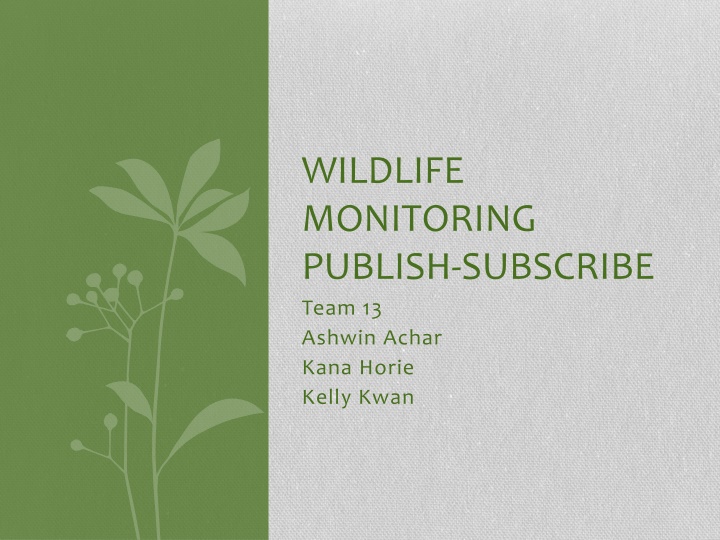
Wildlife Monitoring Publish-Subscribe System for Real-Time Animal Sightings
Discover how our wildlife monitoring system allows users to report animal sightings, subscribe to specific animals, and receive real-time data on nearby wildlife locations. Learn about the system components, testing, and future directions for enhancing user experience.
Download Presentation

Please find below an Image/Link to download the presentation.
The content on the website is provided AS IS for your information and personal use only. It may not be sold, licensed, or shared on other websites without obtaining consent from the author. If you encounter any issues during the download, it is possible that the publisher has removed the file from their server.
You are allowed to download the files provided on this website for personal or commercial use, subject to the condition that they are used lawfully. All files are the property of their respective owners.
The content on the website is provided AS IS for your information and personal use only. It may not be sold, licensed, or shared on other websites without obtaining consent from the author.
E N D
Presentation Transcript
WILDLIFE MONITORING PUBLISH-SUBSCRIBE Team 13 Ashwin Achar Kana Horie Kelly Kwan
Introduction Motivation Track nearby wildlife 1. For researchers: to locate animals of interest to tag 2. For safety: to prevent encounters with dangerous animals 3. For hobbyists: for birdwatchers and animal lovers Goals 1. Users can report animal sightings 2. Reports are filtered for relevance (animal sighting vs. mention) 3. Users can subscribe to a specific animal 4. Users get relevant animal sighting locations near them in real time
Related Work 1. Wildlife Tracking [1] Explore a region with prior knowledge of animal s territory Typically tags with geolocation are attached to animals Tags transmit data to a base station to collect data 2. Data Collection/Relevance Social media feed/text analysis for relevant information[2] Filtering text to predict a location [3] Location inaccuracies depending on time of report References [1] Juang, Philo, Hidekazu Oki, Yong Wang, Margaret Martonosi, Li Shiuan Peh, and Daniel Rubenstein. "Energy-efficient computing for wildlife tracking: Design tradeoffs and early experiences with ZebraNet." In ACM Sigplan Notices, vol. 37, no. 10, pp. 96-107. ACM, 2002. [2] Diakopoulos, Nicholas, Mor Naaman, and Funda Kivran-Swaine. "Diamonds in the rough: Social media visual analytics for journalistic inquiry." In Visual Analytics Science and Technology (VAST), 2010 IEEE Symposium on, pp. 115-122. IEEE, 2010. [3] Han, Bo, Paul Cook, and Timothy Baldwin. "Text-based twitter user geolocation prediction." Journal of Artificial Intelligence Research 49 (2014): 451-500.
System Components Data Subscribers Publishers Broker Text Filter for Relevance
Testing and Evaluation Allow users to publish/submit supposed wildlife sightings Filter submissions for relevant content (data enrichment) Distinguish between likely actual sighting and possible false positive Consideration to timing and location Score submissions Allow users to subscribe to different animals Only show nearby wildlife
Future Directions Improve User Interface and User Experience Integrating Social Media APIs as publishers Improve filter (natural language processing) Filtering data for overlapping/repeating information Displaying locations to the user on a map
